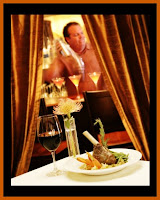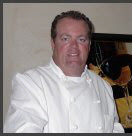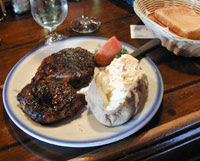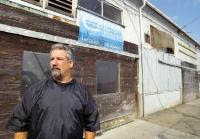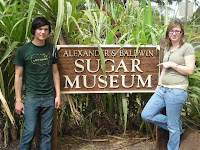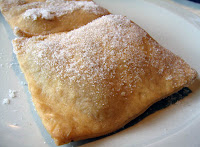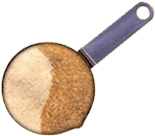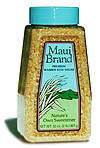 I was a simple Meatcutter when I got into this food sales business. I worked for a 4 location family owned store in the "other" bay area called Diablo Foods. In our Meat Department we processed our own fresh meats, poultry, and seafood. We were more than just a place to buy groceries however, we tried to make shopping there an experience. One of the store motto's was owned and operated by your friends and neighbors. Diablo was a gathering place.
I was a simple Meatcutter when I got into this food sales business. I worked for a 4 location family owned store in the "other" bay area called Diablo Foods. In our Meat Department we processed our own fresh meats, poultry, and seafood. We were more than just a place to buy groceries however, we tried to make shopping there an experience. One of the store motto's was owned and operated by your friends and neighbors. Diablo was a gathering place.Moving from a retail focused enviroment, mainly helping Mrs. Jones decide what she was going to prepare for dinner,

or encouraging Don Dirito (Dirito Brothers VW, Nissan, Saab)to buy a half Ribeye roast to BBQ for his staff on a Sunday to a wholesale enviroment took some adjustment. The Chef is often times more demanding and less trusting than some of our walk up customers at the meat counter.
It was a different world in the restaurant. I've learned something from every Chef, owner, line cook, bartender, and dishwasher I've sold to. But, I admit that I've had some favorite restaurateurs through the years with whom I have worked.
 There was Ken Price from Pegg's Western Grill and Bakery. Ken was an ex-chemical engineer who turned a run down biker bar in Pacheco California to a family friendly breakfast and lunch restaurant. Menu items included names that fit the refinery neighborhood it was in as example the "Pipe-fitter" and the "Longshoreman". I asked Ken once what was the secret to his success and he got a far away look in his eye and said "I was blessed with the taste buds of the common man".
There was Ken Price from Pegg's Western Grill and Bakery. Ken was an ex-chemical engineer who turned a run down biker bar in Pacheco California to a family friendly breakfast and lunch restaurant. Menu items included names that fit the refinery neighborhood it was in as example the "Pipe-fitter" and the "Longshoreman". I asked Ken once what was the secret to his success and he got a far away look in his eye and said "I was blessed with the taste buds of the common man".
 Bob Montague, owner of Cafe Sparrow in Aptos, was another. At the time he was running (what should have been) a high volume restaurant called Clawdaddy's on Cannery Row. He was a "hands on" owner full of passion for his menu, his food, and his guests. While placing an order one busy summer Sunday afternoon, in shock at the rapidly disappearing flatware--he ordered 6 dozen of each item then asked me to do him a favor. "Have your driver throw this away on the way in and save my people the trouble!"
Bob Montague, owner of Cafe Sparrow in Aptos, was another. At the time he was running (what should have been) a high volume restaurant called Clawdaddy's on Cannery Row. He was a "hands on" owner full of passion for his menu, his food, and his guests. While placing an order one busy summer Sunday afternoon, in shock at the rapidly disappearing flatware--he ordered 6 dozen of each item then asked me to do him a favor. "Have your driver throw this away on the way in and save my people the trouble!" Pat Ottone is another. Pat owns Lallapalooza, and Eli's Great American Restaurants. Once we were talking about a menu item that he wanted to put on. He wanted to menu a corned beef sandwich, but it couldn't be ordinary. With Pat every menu item should be an experience, more than a meal. Sure we sampled corned beef, rolls, and mustard..but we also explored the history of the corned beef sandwich. Somehow that led to Katz's Deli (ok only by internet-and as long as you are on the internet check it out at http://www.katzdeli.com/. Since 1888 they have been around. You've seen it in movies and on TV) In fact the concept of Lallapalooza is to make you, the customer part of the restaurant, which is why everything is open and intermingled.
Pat Ottone is another. Pat owns Lallapalooza, and Eli's Great American Restaurants. Once we were talking about a menu item that he wanted to put on. He wanted to menu a corned beef sandwich, but it couldn't be ordinary. With Pat every menu item should be an experience, more than a meal. Sure we sampled corned beef, rolls, and mustard..but we also explored the history of the corned beef sandwich. Somehow that led to Katz's Deli (ok only by internet-and as long as you are on the internet check it out at http://www.katzdeli.com/. Since 1888 they have been around. You've seen it in movies and on TV) In fact the concept of Lallapalooza is to make you, the customer part of the restaurant, which is why everything is open and intermingled.This brings us to the Central Coast Calamari cutting. Trying to find the best product for my Calamari customers. Of course there are traditionalist out there that must prepare their own fresh squid. Sea Harvest Restaurants fish, process, cook, and sell their products not only to retail customers but wholesale and for export. Tony at the Crown and Anchor cuts, batters, and fry's his own Calamari steaks. This however is about value added products to accent an appetizer menu.
The two products we review are not competing against each other, rather they both have a slightly different niche to fill. The first is from Eastern Shore Seafood and is a battered Calamari Strip. The second is from Tampa Maid and is a mix of rings and tenticles "lightly dusted" in a seasoned flour.
Please enjoy the results of our tests!







